Using Facebook Custom Audiences is a crucial part of any Facebook ad strategy. And it’s a rewarding one – advertisers using these audiences in their remarketing campaigns see a lift-up in clicks and conversions.
If you’re not using Custom Audiences, you are missing out on opportunities for getting better results and lowering your Facebook ads cost.

You don’t want to miss this treat
As with all Facebook advertising, there are a million possible ways to create and use the Custom Audience feature. And if you’re just starting, it can be terrifyingly confusing. 🤯
Much of the Facebook advertising success depends on setting your audiences and account structure correctly, right at the foundation.
Custom Audiences are often used for two purposes:
- Setting up remarketing campaigns
- As a source audience when creating Lookalike Audiences
But let’s not jump too far ahead of ourselves. What you need to know is the answer to this one question: Do you want to improve your Facebook advertising results? If the answer is YES, keep reading!
We’ll start with the basics. After, we’ll move on to some Facebook Custom Audience strategies, and then finally give step-by-step instructions for setting up any kind of Custom Audience – we’ve got you covered!
But first, let’s begin with the most obvious question…
What is a Facebook Custom Audience?
As explained by Facebook: A Custom Audience is an ad targeting option that lets you find your existing audiences among people on Facebook.
You can create Custom Audiences of people who already know your business by using sources like customer lists, website or app traffic, or engagement on Facebook.
After you create an audience, Facebook’s algorithms will find relevant people’s profiles on the platform. Once these people are identified, Facebook will make sure that your ads reach their news feeds and other placements.
Advertisers use Custom Audiences to set up retargeting campaigns so that they can reach people who have already been on their website, added items to the shopping cart, etc.
Here are the results of a Facebook ad campaign from the US. As you can see, the Remarketing campaign (that uses Custom Audiences) had the lowest Cost per Purchase and the highest Return on Ad Spend (ROAS)

Custom Audiences help to get higher ROI
The main reason that Custom Audiences work so well is that people in those audiences already know your brand and have engaged with your branded content. When they see your ad, it will be highly relevant for them.
For example, The New Yorker has built up a multi-layer Facebook ad targeting strategy. First, they attract new users by promoting some of their top news stories and reporting.
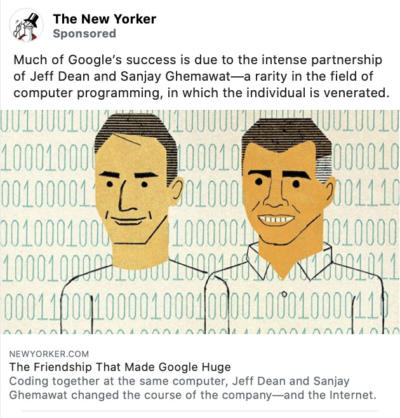
The New Yorker promotes its top news articles
After a user has visited their website and read some of the articles, The New Yorker can reach them with a remarketing campaign that offers a special subscription deal.
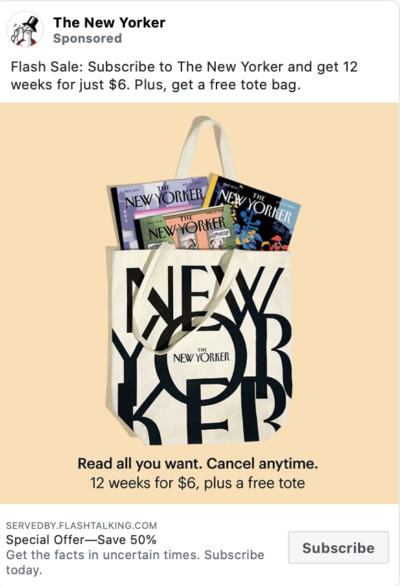
The New Yorker’s remarketing ad
How can they reach an audience of people who have already visited their website? By using Facebook Custom Audiences, of course!
Types of Facebook Custom Audiences
As you start to create a Custom Audience in the Facebook Audience Manager, you’ll be presented with an almost confusing assortment of options.
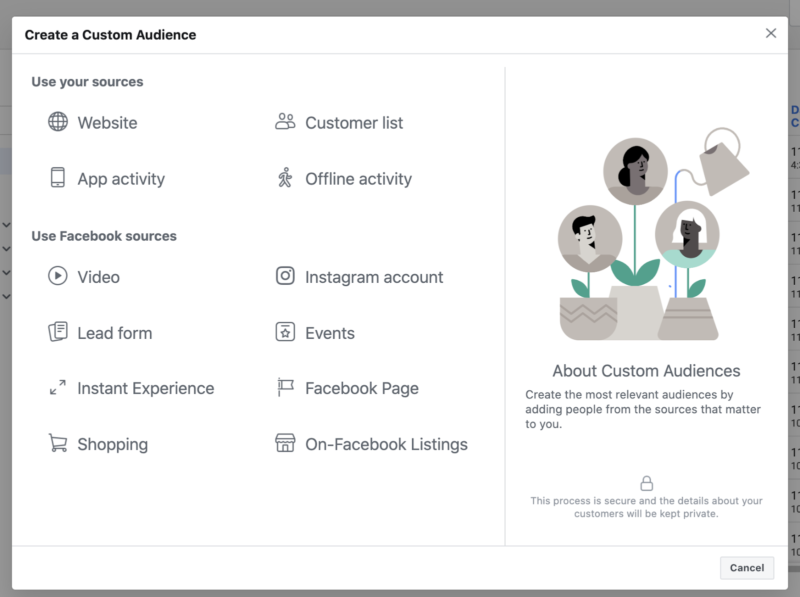
Facebook Custom Audience types
In fact, there are 12 types of Facebook Custom Audiences, each with a different source:
- Website
- Customer list
- App activity
- Offline activity
- Video
- Instagram account
- Lead form
- Events
- Instant Experience
- Facebook Page
- Shopping
- On-Facebook Listings
That’s a lot… But we’ll make sense of it!

Hold on; it’s not that complicated!
Let’s take a look at how each of them works and whom you can target through those options.
Tip: If you’re just starting, you can only use the “Website” option to reach people who have visited your website or specific landing pages.
💻 Website Custom Audiences
Website Custom Audiences match people who visit your website with people on Facebook. To create this type of audience, you need to have the Facebook pixel installed on your website.
See Facebook’s official guide for setting up the website pixel.
📜 Customer list Custom Audiences
As its name hints, the Customer list Custom Audience is created based on a list of people. You generate the list itself. That is, you can include your existing customers’ names, emails, and phone numbers.
After you upload a list, Facebook uses a process called matching to match your uploaded information with corresponding Facebook profiles – so that you can advertise to your customers on Facebook, Instagram, and Facebook Audience Network.
P.S. It is not allowed to use any list of people who are not your customers and haven’t permitted you to use their personal data for marketing purposes.
📱 App activity Custom Audiences
This option allows you to target people on Facebook based on the actions they have taken within your app – mobile or desktop. For example, you could target people who have previously used your app but did not open it for the past 30 days.
For example, Spotify could use this Custom Audience type to target listeners with low activity, offering them a free month of the Premium listening plan.
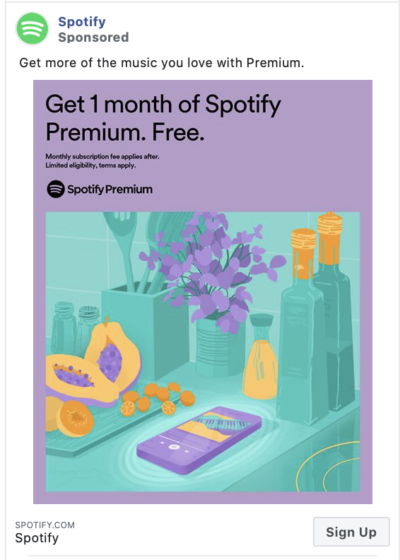
Spotify Facebook ad example
🏘️ Offline activity Custom Audiences
If you’re operating a brick-and-mortar store and want to reach people who have been near it recently, this is the way to do it. You can target people based on the offline actions that they took in your physical store.
To use this option, you need to create an offline event set in Facebook Events Manager and associate it with an ad account. You also need to upload interaction data from your physical store locations to the Events Manager.
🎬 Video Custom Audiences
Facebook allows advertisers – that’s you – to create a Custom Audience based on people who saw your video on Facebook or Instagram.
This remarketing audience is often part of a multi-layer advertising strategy: the advertiser starts by promoting an engaging video and later retargets the people who watched 50% or even 90% of the video.
💕 Instagram account Custom Audiences
If your brand is big on Instagram, this one’s a must-have audience. This option allows you to create an audience of people who engaged with your branded content on Instagram.
For example, Starbucks could create a Facebook audience of people who engage with their Instagram posts and stories…
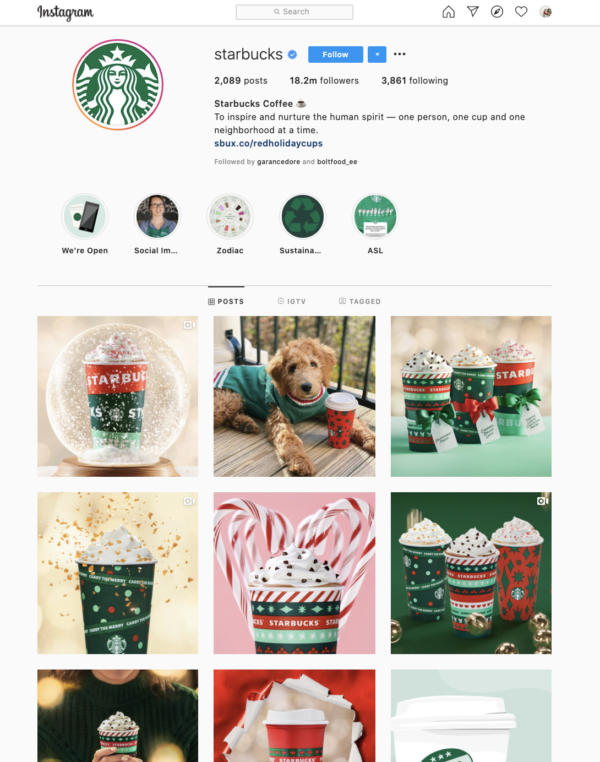
Starbucks’ Instagram is engaging
… and target this audience to promote new products across both Facebook and Instagram platforms. The result? – Increased sales and cafe visits.
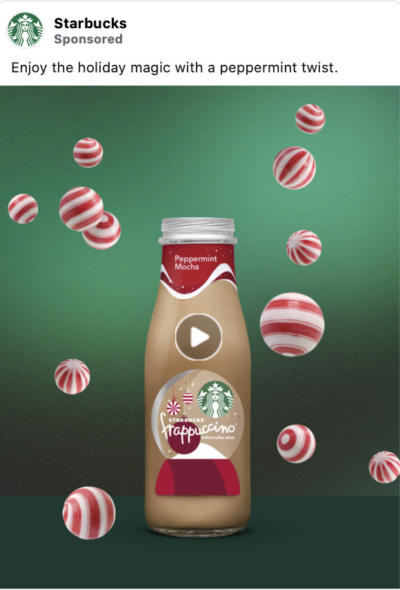
A very yummy Facebook ad!
⭐ Lead form Custom Audiences
If Facebook Lead Ads are part of your marketing strategy, this Custom Audience type will come in handy. Using this option, you can target people who opened your Facebook lead form. Alternatively, use it to target those users who opened but didn’t submit the form.
🎡 Events Custom Audiences
Is your brand organizing events and setting up Facebook events to promote them? If your answer was “Yes,” then you could use this Custom Audience type for retargeting people who have engaged with or shown interest in your upcoming or past Facebook events.
🍪 Instant Experience Custom Audiences
Instant Experiences are full-screen mobile advertisements on Facebook. Creating them is painstaking work, and that’s why mostly bigger advertisers with large advertising budgets use this feature.
However, if you’re one of the marketers using Facebook Instant Experiences, know that you can target people who have engaged with them.
💎 Facebook Page Custom Audiences
Creating a Custom Audience out of people who have engaged with your Facebook page is an easy way to reach your Facebook page fans and your ads’ audience. You can only target people who engaged with the Facebook pages that you own, so you can’t target the audiences of other brands’ pages.
For example, you could use the Facebook Page Custom Audience to promote your email newsletter. You can turn the people engaging with your Facebook posts into newsletter subscribers.
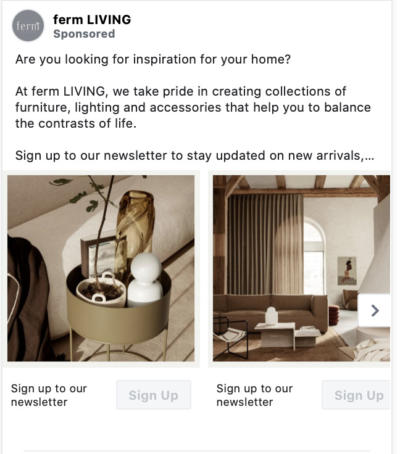
Ferm Living promotes its newsletter
🛒 Shopping Custom Audiences
This is one of the most important Facebook Custom Audiences and an essential targeting option for any brand with an online store.
Using this audience type, you can reach people who interacted with your products in a shopping experience on Facebook and Instagram. Additionally, you can target people who added items to the shopping cart, viewed specific products, and much more.
🛍️ On-Facebook Listings Custom Audiences
On-Facebook listings are the products available on the Facebook Marketplace. Similar to Shopping Custom Audience, this targeting option allows you to reach people who have engaged with your products on the Facebook Marketplace.
Now that you’re aware of all the different Facebook Custom Audience types, let’s check out the TOP 10 use cases for Facebook Custom Audiences that we have seen work for many brands.
P. S. If you’re interested in learning more about other Facebook audience types, see this guide: Facebook Ad Targeting in 2020 – Reach the Right Audience for Higher ROI.
TOP 10 Facebook Custom Audiences with high ROI
There are thousands of different Custom Audiences that you can create. But which ones are worth the effort?
Up next, we’ll share our TOP 10 suggestions. Make sure to add some of these Custom Audiences to your Facebook ad campaigns to see an improvement in ROI.

Custom Audiences are a sweet deal
- All website visitors of the past 30 days
- Visitors of specific landing pages
- Pricing page visitors
- Website leads and freemium users
- Engaged online store shoppers
- Shopping cart abandoners
- Customers of the past 180 days
- Blog readers of the past 30 days
- Instagram page engagements
- Facebook video engagements
Tip: Note that you can also create a Lookalike audience of all of these Custom Audiences to reach more similar people with these high-value Facebook users.
In the following section of this article, we will explain why the TOP 10 Custom Audience ideas work and how to use them. For detailed setup instructions, scroll down to the last section of the article.
❗Important! When setting up your Facebook remarketing campaigns, make sure to create Custom Audiences of people who already converted and exclude them from your target audience.
1. All website visitors of the past 30 days
If you were allowed to only set up one Facebook Custom Audience, this would be it.
Also, the Custom Audience of past 30-days website visitors is the best remarketing audience for small advertisers. To clarify, if you don’t get a high traffic volume to your website, it is best not to segment your targeting too much.
Pro tip: It is better to have one Custom Audience of 10,000 people than ten Custom Audiences, each including 1,000 people. If you spread your audiences too thin, Facebook algorithms will have a hard time optimizing the delivery.
To offer an example, let’s take a look at Squarespace. Below, you can see the home page of their website building tool.
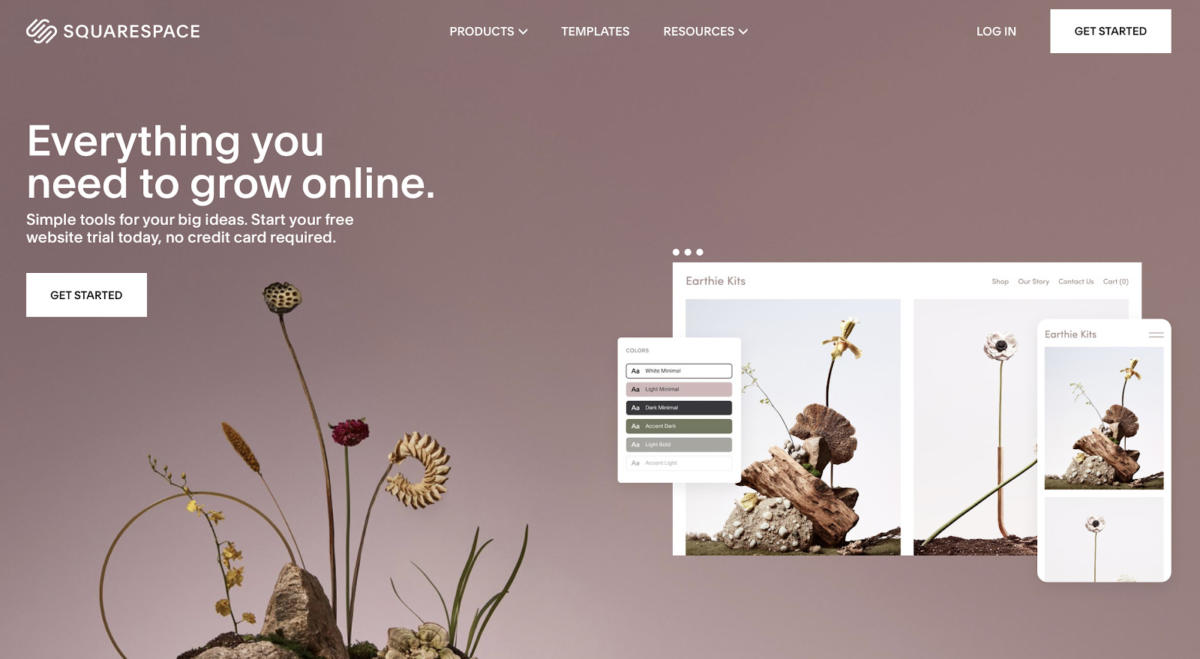
Squarespace website
As they set up their online ads for remarketing, Squarespace tries to follow a similar design on both the website and Facebook ads. In this way, people can easily recognize their ads, especially after they’ve visited the website.
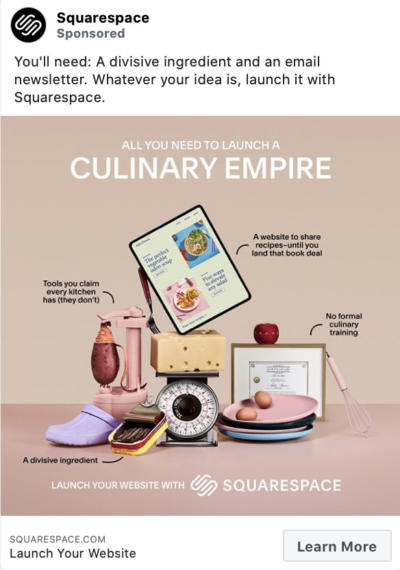
Squarespace Facebook ad example
When targeting a Custom Audience of past website visitors, it is best to keep your ad messages broad so that they resonate with all of your product’s use cases. The offer promoted in Facebook ads shouldn’t vary too much from the key value proposition you showcase on your website’s home page.
You can either use the remarketing ads to past 30 days’ website visitors to lead people back to your website or custom landing pages that help to take them further in your marketing funnel.
2. Visitors of specific landing pages
If your product has several use cases or is used by clients with varying needs, you may need to create multiple landing pages to present all available options.
For example, in addition to their bread-and-butter product – email newsletter management platform – MailChimp also provides tools for website building and social media marketing.
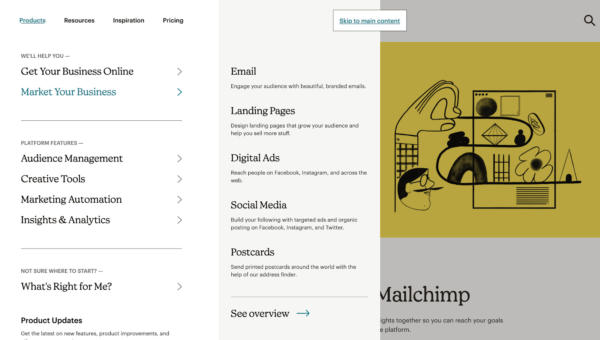
MailChimp has many different products and landing pages
Based on the MailChimp example, they could create separate Custom Audiences of people who visited their home page, email marketing landing page, social media marketing landing pages, etc.
Naturally, each landing page’s Custom Audience also requires a different set of Facebook ads. There is no point in advertising social media marketing tools for someone interested in building email newsletters. Below, you can see an ad example that MailChimp could advertise to their social media marketing landing pages’ visitors.
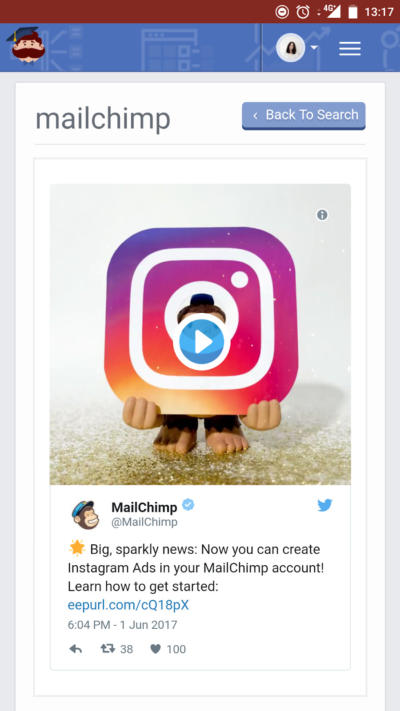
MailChimp ad example
Key takeaway: Create Facebook Custom Audiences of different landing pages’ visitors to show them ad creatives with different messaging, depending on the landing page they visited.
3. Pricing page visitors
Not all website visitors convert on their first visit. Some won’t even convert after their second or third visit.
Often, the reason for this is that people consider your product too expensive.
By creating a Facebook Custom Audience of your Pricing website page visitors, you can reach people who have shown high interest in your product and checked out how much it costs.
Tip: To add an extra incentive for people to click on your Facebook ads and complete their purchase, you can add a small discount offer.
For example, Restream is retargeting their Pricing page visitors with a limited-time -20% discount offer.
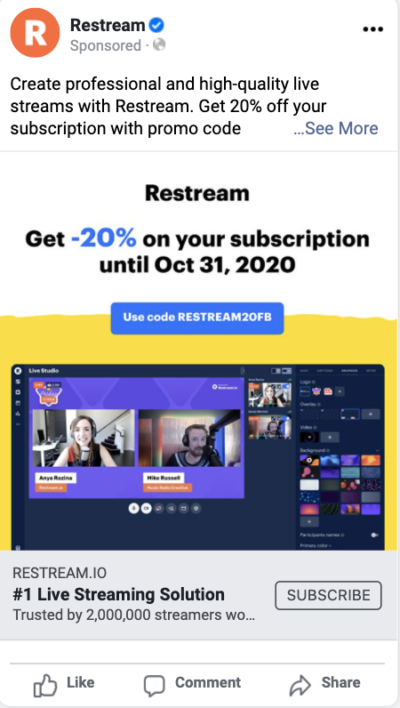
Restream discount offer
We recommend to create Custom Audiences of people who visited your Pricing page in the past 30 days, but you can also extend the period to the past 60 or 90 days.
4. Website leads and freemium users
Today’s trendy pricing scheme is the freemium model: customers can use the product for free but need to pay for ad-free usage or Premium features and content.
One example is Spotify. You can listen to their music streaming platform or free, but you’ll have to pay $9.99 monthly to enjoy music ad-free. This model is widely popular with SaaS (Software as a Service) products.
By creating a Facebook Custom Audience out of your freemium users or unpaying leads, you can show them additional remarketing ads that help to convert them into Premium and paying subscribers.
For example, Spotify is advertising their free plan to new users.
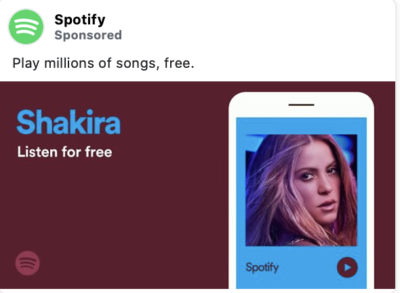
Spotify’s Facebook ad for new users
Once a user has signed up for the free plan and seems to enjoy the service, Spotify can retarget them with a Facebook ad containing a special offer for their premium plan.
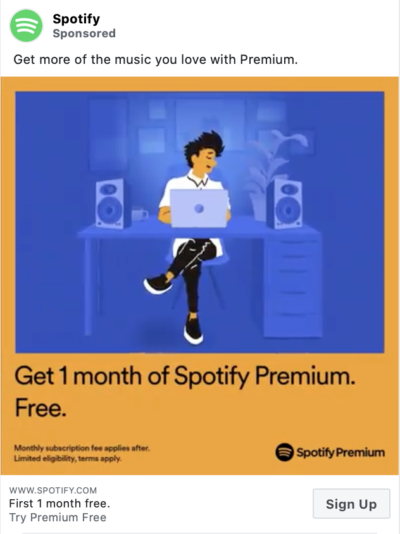
Spotify’s Facebook ad for Premium
Tip: If you want to get more people to convert into paying subscribers, you can offer them the first month for free. This way, they can see all the benefits without committing to pay immediately.
Another type of Facebook ads that work well with Custom Audiences of freemium users and leads are ads promoting case studies and testimonials. Like the below example by Intercom.
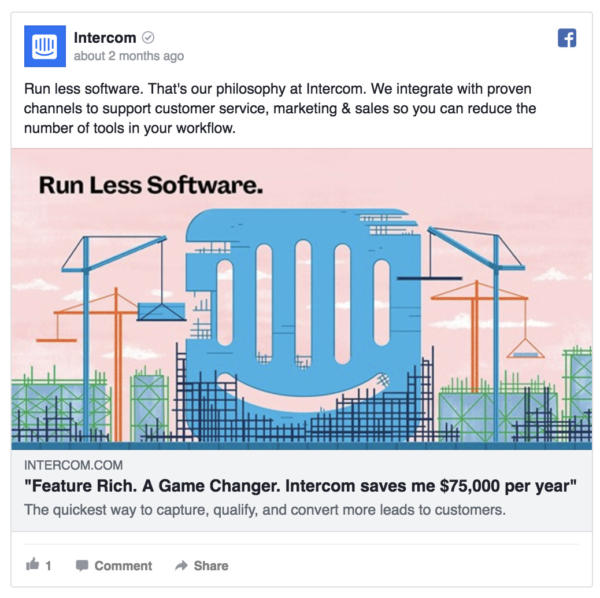
Intercom is advertising a customer success story
The first four Custom Audience ideas were relevant mostly for small advertisers and online services. If you’re running an e-commerce store, the next three audiences are a must-have.
5. Engaged online store shoppers
Engaged online shoppers are the people who have visited multiple product pages in your online store but didn’t yet purchase anything.
By using Facebook’s feature of Shopping Custom Audiences, you can reach people who have taken one of the following actions (the list is even longer!) in your brand’s Shop on Facebook or Instagram:
- Viewed your Facebook Shop’s page
- Saved your product(s)
- Viewed your Shop’s Collection Page(s)
- Looked at your product(s) on a Product Details Page
Similarly, you can target the same audiences in your online store that’s off Facebook’s platform.
In general, these audiences react well to hyper-targeted dynamic remarketing ads as well as discount offers.
For example, the below ad example by The Kooples shows to viewers the products they have previously checked out in the online store.
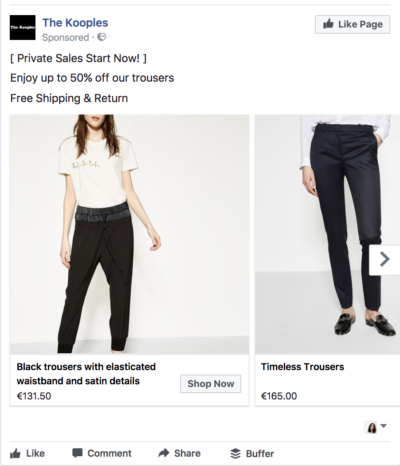
Dynamic Facebook remarketing ad
To create a Custom Audience of engaged shoppers of your Facebook Shop, use the Shopping Custom Audiences. To set up a Custom Audience of your online store’s engaged shoppers, you will need to use the Website Custom Audience (as the store is off Facebook and, thereby, on a website).
6. Shopping cart abandoners
The shopping cart abandoners are people who add items to the shopping cart but leave before completing their purchase.
According to Statista, up to 80% of online store visitors abandon their shopping carts.
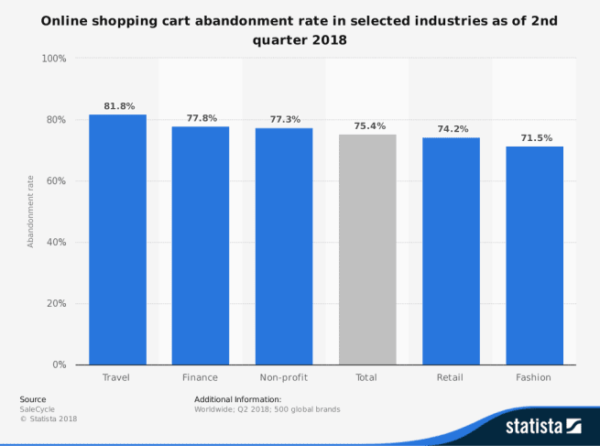
Shopping cart abandonment rate is very high – Image source
And yet, the shopping cart abandoners are an audience so close to converting that it would be a shame not to follow up and show them some Facebook ads.
If we were to discover a Facebook ad account that doesn’t yet target this Custom Audience, it would be our priority #1 to get it fixed.

Setting up those Custom Audiences
Like the Engaged Shoppers audience, you can attract people back to your online store with special offers. Even better if you make them limited-time. 😉
Tip: If you don’t want to offer a flat discount on your entire product range, you can copy Cos’ tactics and offer special discounts on various product lines.
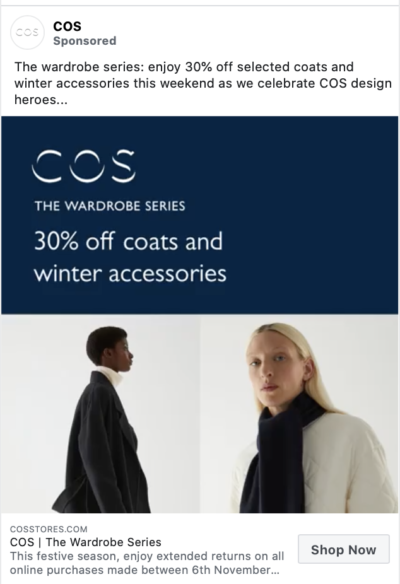
Cos’ ad promotes a limited-time discount
Here are some more discount offer ideas for your Facebook ad campaigns:
- Offer a flat 20% discount on all products
- Discount selected products by 30% or 50% for a limited-time sales period
- Advertise a promo code, e.g., “Get €10 off your first purchase with a special promo code HELLO10”
To set up a Custom Audience of shopping cart abandoners, you need to create a Website Custom Audience that includes people who added items to the shopping cart and excludes those who completed the purchase.
7. Customers of the past 180 days
Why would you target people who have already completed a purchase?
Of course, because you want them to buy more stuff!
According to GrooveHQ, the probability of selling to cold audiences is 5-20%, while the chances of selling to existing customers are as high as 60-70%.
Here’s more: based on eMarketer’s data, almost three out of five U.S. online buyers claim to spot ads for products they’ve previously looked up or purchased.
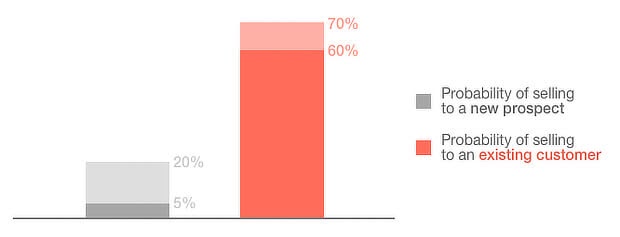
Don’t forget your existing customers – Image source
Your existing customer base is familiar with your brand, and there’s a high chance that they like your products. This familiarity means that they’re likely to buy again.
You just need to be on top of their mind when they need your product.

Many advertisers compete for your customers’ attention
To stay top of mind, many large brands run ongoing brand awareness campaigns. The goal is to ensure that people remember the brand.
The examples include brands from Coca-Cola and Burger King to car manufacturers. And we bet that these ads are also shown to their past 180 days’ customers.
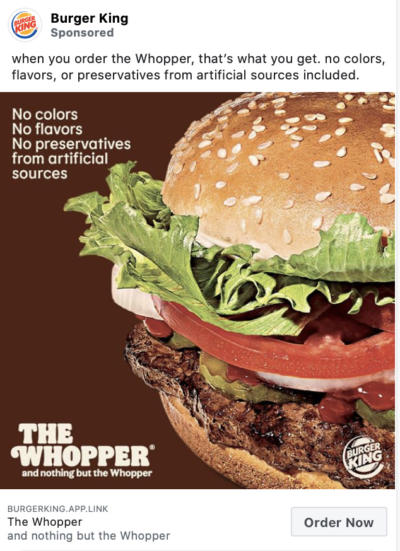
Burger King’s advertising their flagship burger
To create a Custom Audience of your past 180 days’ customers, create a Website Custom Audience of people who have completed a purchase in the past 180 days. You can exclude people who have completed a purchase in the past 14 days so that they get a break before seeing your remarketing campaign.
8. Blog readers of past 30 days
Building up a loyal blog readership is a challenge. So once you have people engaging with your blog content, you better keep them coming back!
By targeting a Custom Audience of the past 30 days’ blog visitors, you can build up a group of thousands of loyal readers over time.
Here’s how it works:
- Someone lands on your blog and reads an article
- A Facebook ad promotes another one of your articles
- They keep returning to the blog through Facebook ads until it develops into a habit
- The user visits your blog on their own (or subscribes to your blog newsletter)
On top of it, you can promote gated content – that’s content that asks people to leave their email to download the materials) such as e-books and guides to your past blog readers.

Leadpages promotes an e-book
Tip: You can create multiple Custom Audiences that are segmenting based on the blog articles’ topics. This way, you can promote your future blog articles to highly relevant remarketing audiences.
How to target past blog readers: Set up a Website Custom Audience and include everyone who has visited landing pages that contain “/blog.” If your blog articles’ URL doesn’t include the “/blog” slug, enter their full URL slugs when creating the audience.
9. Instagram & Facebook page engagements
Most marketers put a lot of effort into creating high-quality content for their Facebook and Instagram pages.
However, their fans might not see all the posts because they follow too many brands on Instagram, or your posts never reach their feed on Facebook.
SocialFlow has analyzed more than 3,000 posts by publishers on Facebook and found that organic reach dropped 42% between January and May 2016.
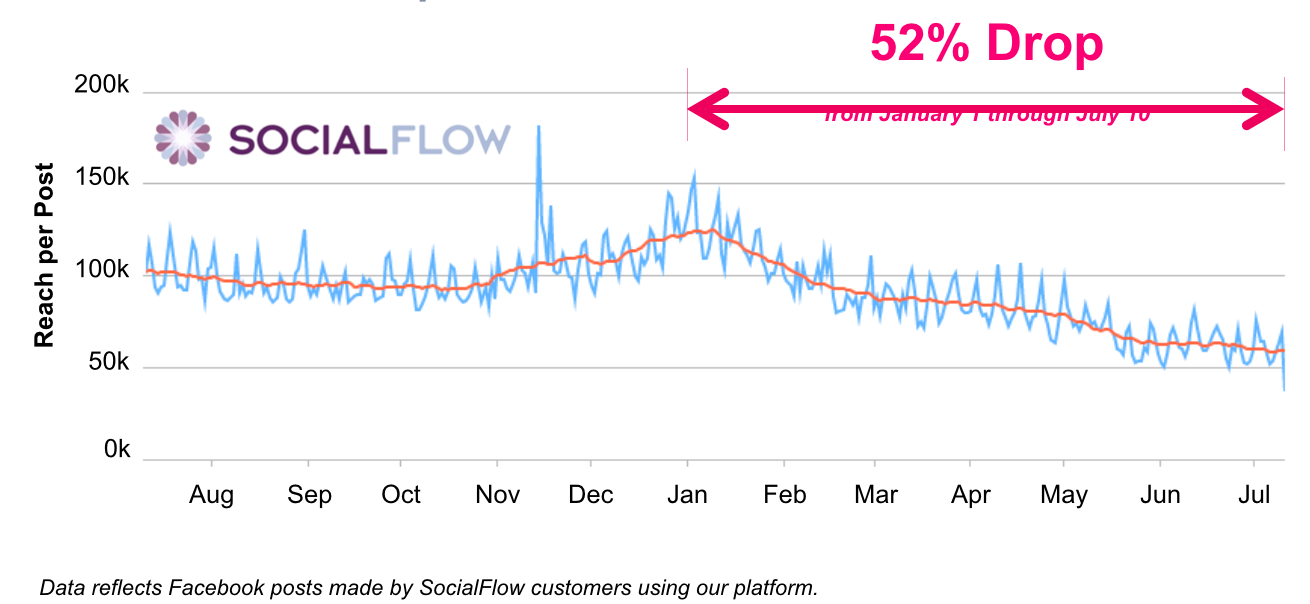
It has dropped even further since – Image source
So how to ensure that your Facebook posts’ engagement is going ⬆ while the organic reach is steadily going ⬇ ?
The solution to this is investing in the paid promotion of your Facebook and Instagram posts.
We see this strategy working especially well on Instagram, where every hour, tens of new posts appear on top of people’s feeds. The more followers you have, the lower your overall engagement rate will be.
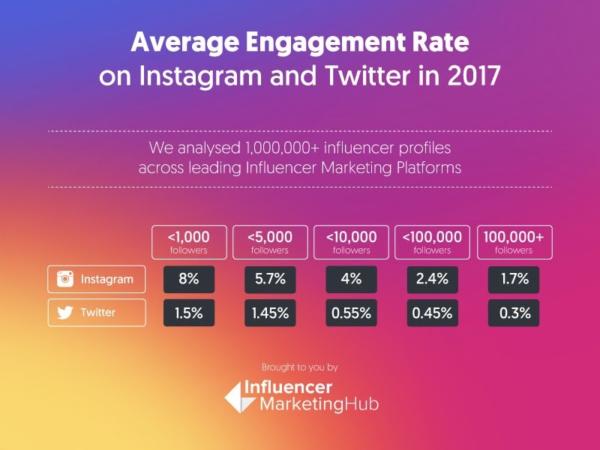
More followers = lower engagement rate – Image source
Here’s an example by M·A·C Cosmetics. They have 23.4m followers on Instagram, so to ensure that their posts reach more people’s feeds, they could set up a promoted Instagram ad.
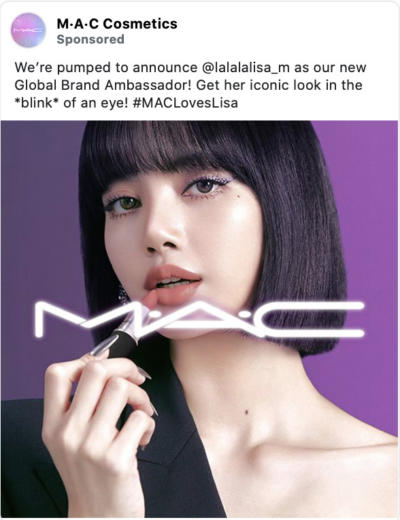
M·A·C Cosmetics Facebook ad
How to target your Instagram followers: Create an Instagram page engagement Custom Audience and target people who follow your page or have engaged with your posts.
10. Facebook video engagements
One of the most commonly used Facebook PPC strategies is to start showing a broad audience engaging video ads.
Next, the advertisers can set up remarketing ads of users who watched 75%, 90%, or 100% of the video.
This strategy works especially well for eCommerce brands – you can first build on brand awareness and then convert the engaged audiences into customers.
For example, H&M is running a video ad to their Swedish audience.
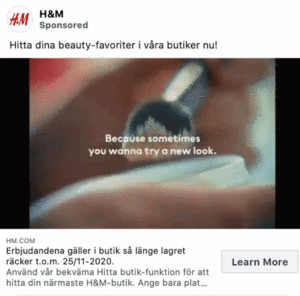
H&M’s brand awareness video ad
Afterward, they can create a Facebook Custom Audience from everyone who has watched the video and promote specific beauty products.
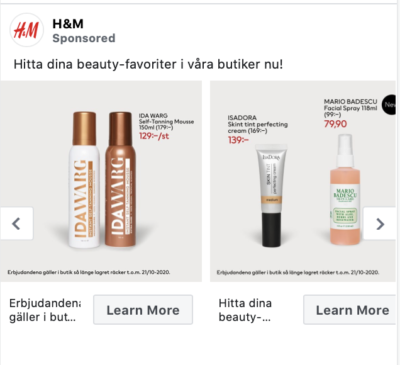
H&M’s sales-oriented Facebook ad
If you show shopping-oriented ads to a cold Facebook audience, they may not engage with the ads as they’re unfamiliar with your brand. However, after seeing an attractive lifestyle video ad beforehand, people are more likely to engage with your shopping ads.
How to retarget Facebook video viewers: Create a Video Custom Audience and select the videos whose viewers you wish to target. Set the minimum video view percentage to 75% or 90% if you want to reach a highly engaged audience.

High five!
Alright! Now that you’re equipped with new ideas for top-performing Facebook Custom Audiences, it’s time to set them up. Follow the last part of this guide for a step-by-step guide on how to set up different types of remarketing audiences.
But first, there’s one more thing to keep in mind: the “Exclude” feature.
Including and excluding Custom Audiences
Don’t forget to use the “Include More” and “Exclude” feature when creating Custom Audiences. These commonly overlooked settings can save you a lot of money.
Additionally, make sure you exclude specific audiences when setting up remarketing campaigns. You probably don’t want to show ads to a user who’s already converted, right? Use the “Exclude” feature to un-target users that have already visited specific landing pages or performed a particular action (e.g., a purchase).
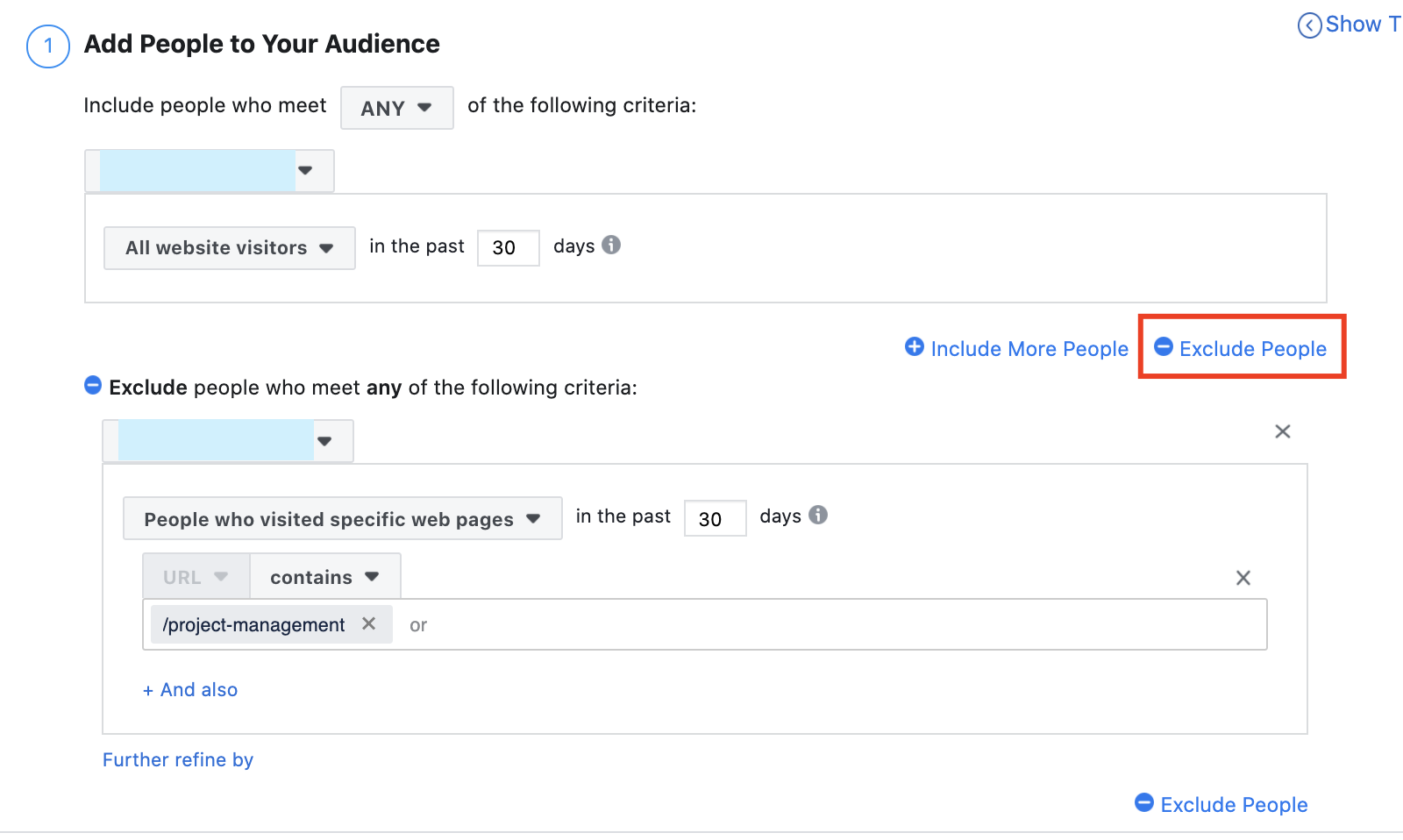
Exclude some website visitors from your Custom Audiences
Bonus tip: Similarly, you can use both of these features to create Facebook audiences that serve concrete goals. For example, you can make an audience designed to show a different ad to users based on their last visit. For example, you can target all website visitors in the past 90 days, then exclude visitors of specific landing pages.
How Facebook Audiences Work
Facebook audiences allow you to select who sees your ad on Facebook. Considering that over 2 billion people use Facebook, you’ll want to make sure you show your ads to the right people. Creating and using the right audience will make a colossal impact on your advertising success.
Facebook provides you with different methods of creating an audience. You have three primary audience types to choose from:
- Saved Audience
- Custom Audience
- Lookalike Audience
Let’s zoom in on Custom Audiences and learn how you can set up various forms of this audience type.
Note that creating Facebook Custom Audiences starts with the same process.
First, open Facebook Business Manager. Click on the upper left corner menu. Navigate to the Assets column, and select Audiences from the menu below to create your Facebook Custom Audience.

Open your audiences page in Facebook Business Manager
Click on the blue “Create Audience” button and select Custom Audience from the drop-down options.
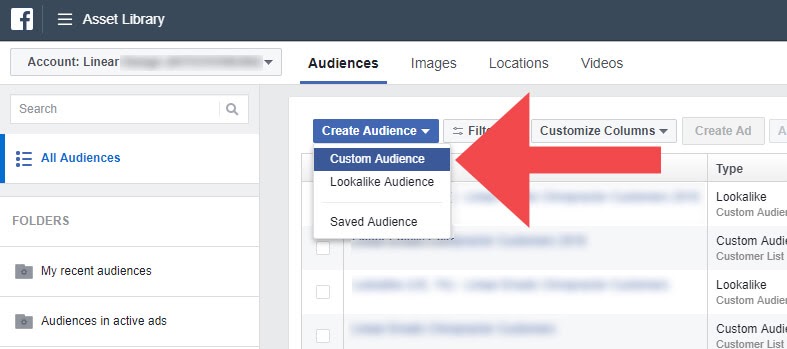
Create a Facebook Custom Audience
This action will open a “Create a Custom Audience” page with 5 options. The creation process will differ for each audience type from this point, so let’s dive in.
1. Create a Facebook Custom Audience from a Customer File
Remember, this audience is built from a company email or customer list of people who willingly provided you with their contact information. Facebook then uses the data to match each subscriber to the corresponding Facebook user. Here’s how:
👉 Once you click the Custom Audience button, select Customer File.
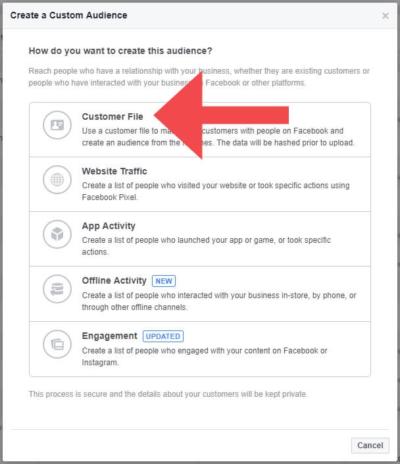
Making a custom audience from a customer list
👉 Select the data upload method: import or upload.
For this example, we select “Add customers from your file or copy and paste data.”
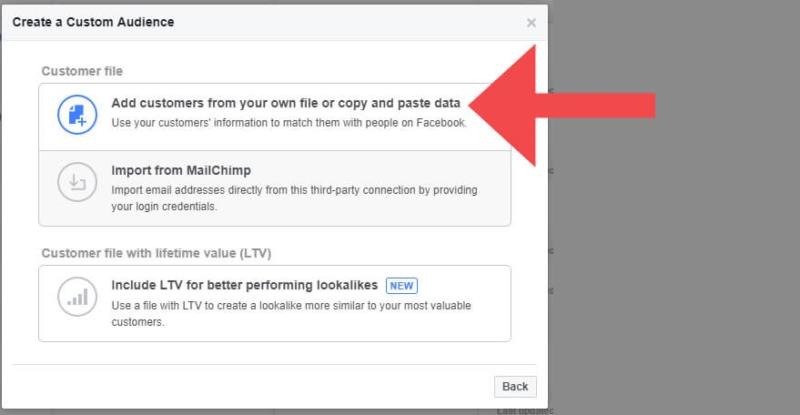
Add your customer file
👉 Upload your list
You can copy and paste contact data, or upload a .csv file. Click Next.
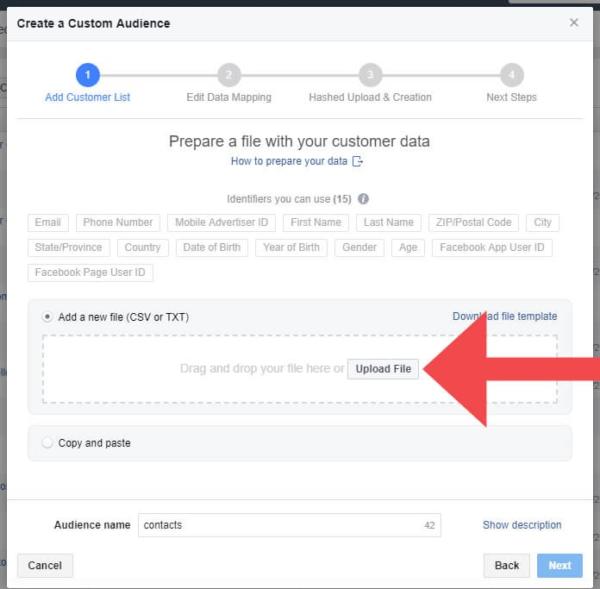
Uploading your files
👉 Double-check audience mapping.
Facebook allows you to double-check the data mapping. This tells Facebook how to use the information you’ve provided. Use the drop-down menus to check that each field correctly describes the data in its corresponding column.
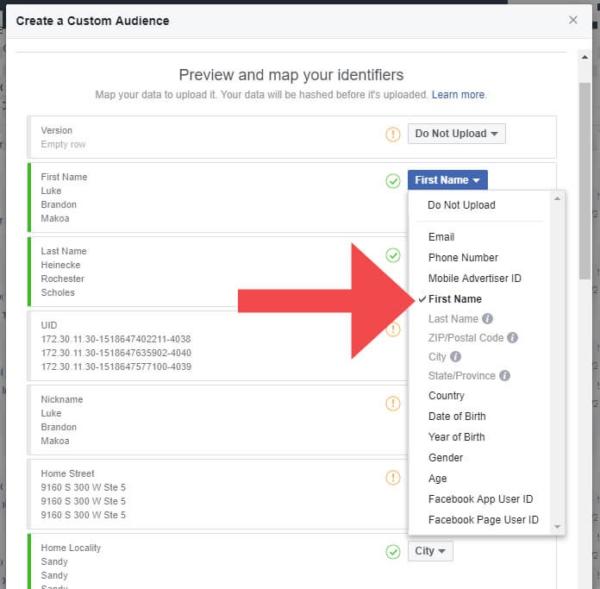
Correctly map your customer file
👉 Finish creating your new custom audience by clicking Upload & Create.
Facebook will organize and match data to users. All of the matching users are placed into your custom audience.
2. Create a Facebook Custom Audience from Website Traffic
This is probably the Custom Audience that you are going to use most often.
To reiterate, you can remarket to website visitors who’ve visited your site or individual pages on the site within a given timeframe.
Here’s how to make this audience in Facebook Ads Manager:
👉 Click on Website Traffic in the custom audiences list.

Making a custom audience from past website visitors
👉 Set conditions for website traffic.
Decide whether your audience must meet one or all of the conditions you set. For this example, we select “All” from the drop-down.
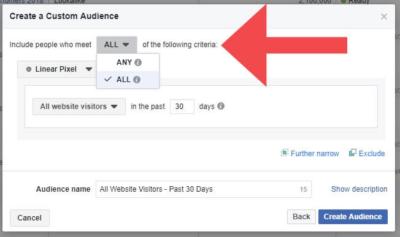
Setting conditions for your custom audience
👉 Specify which visitors should be included in your audience.
You can include anyone who visited your website, visitors that viewed individual pages, or a combination of pages.
👉 Enter a timeframe in the past 1 to 180 days.
For example, we select “All website visitors” from the drop-down and leave the default “past number of days” at 30.
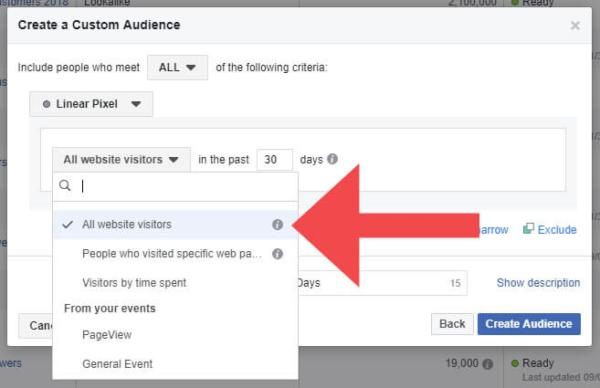
Select which pages’ visitors you want to target
👉 Name the audience; for this example, “All Website Visitors – Past 30 Days”.
Click Create Audience and you’re done. Facebook automatically updates this audience with users that have visited your website in the past 30 days.
3. Create a Facebook Custom Audience from App Activity
If you’re marketing an app, you can create an audience consisting of Facebook users that have completed specific app events. You can select from the premade events or create your custom events and specify a timeframe.
👉 Click on the custom audience option “App Activity.”
👉 Decide who to include in your audience. You can include or exclude based on custom actions you’ve specified.
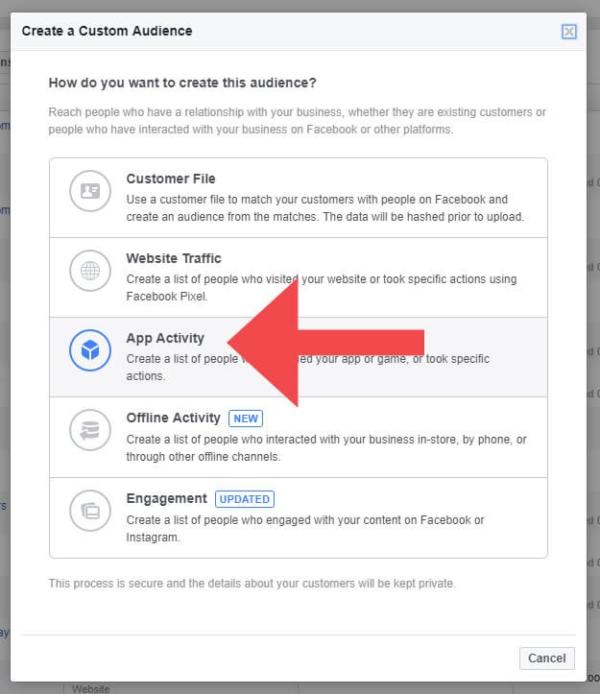
Making an audience from app activity
👉 Name and finish the audience. Only apps registered with your account will be available to select using the dropdown.
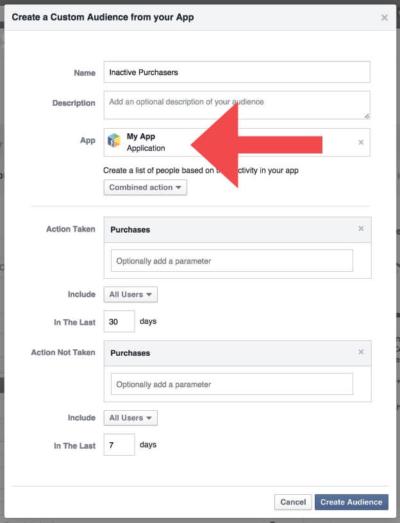
Select your app and set conditions
4. Create a Facebook Custom Audience from Offline Activity
Not too long ago, it was almost impossible to track who interacted with your business or purchased products and services offline.
Offline Activity is a reasonably new feature that allows you to sync in-store POS data or CRM data with Facebook. With that data, you can create a Custom Audience of users that interacted with your brand offline within a given timeframe.
For example, if the data allowed, you could create an audience that includes only patients who’ve been to your dental office for a root canal in the last thirty days.
Creating this audience is very simple.
👉 Click on Offline Activity.
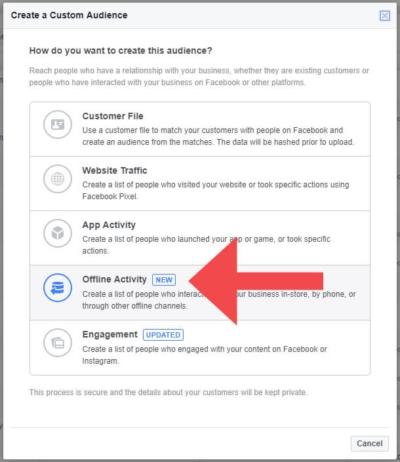
Select “Offline Activity”
👉 Select “People who interacted offline” from the drop-down. Next, enter a timeframe in the past 1 to 180 days.
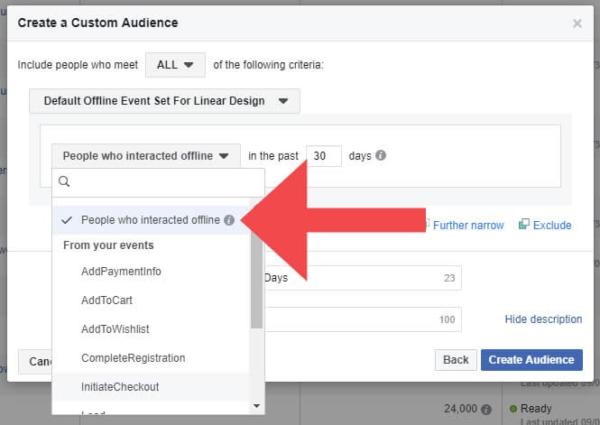
Choose who you want to be included in your custom audience
👉 Name and finish the audience. For this example, we name the audience “New Patients – Past 30 Days”.
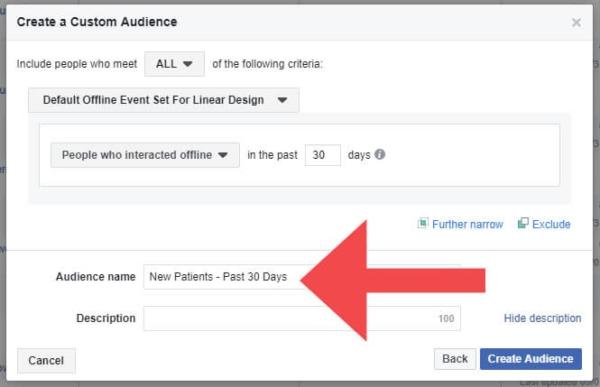
Give your audience a name
Click the blue Create Audience button. Facebook will automatically update this audience with users who interacted with your app during the timeframes you specify.
5. Create a Facebook Custom Audience targeting Video Engagement
Videos get more engagement than any other type of post on Facebook despite only making up 3% of the content. This means putting video to use in your ads can help you stand out and contribute to better overall results. More importantly, you can target users who have viewed your videos and remarket to them.
👉 Select Engagement as your custom audience option. You’ll need to choose one of the six types of engagement options.

Create a Facebook Custom Audience from engagement
👉 Select the first option on the list titled “Video.”
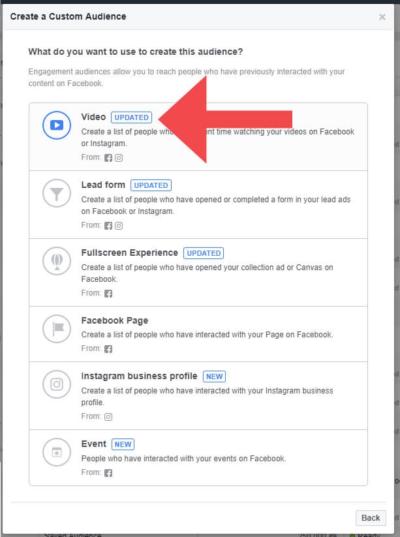
Make a custom audience from video engagement
👉 Under “Browse,” choose audience criteria based on the duration of user engagement on a video. In this case, duration is either the number of seconds or the percentage watched.
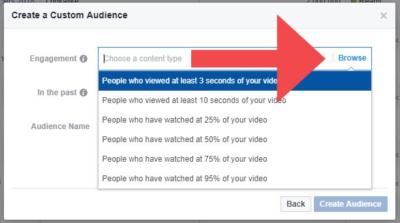
Target by how customers engaged with your video
👉 In the dropdown menu, select the page that contains the video or videos you want to use for this audience.
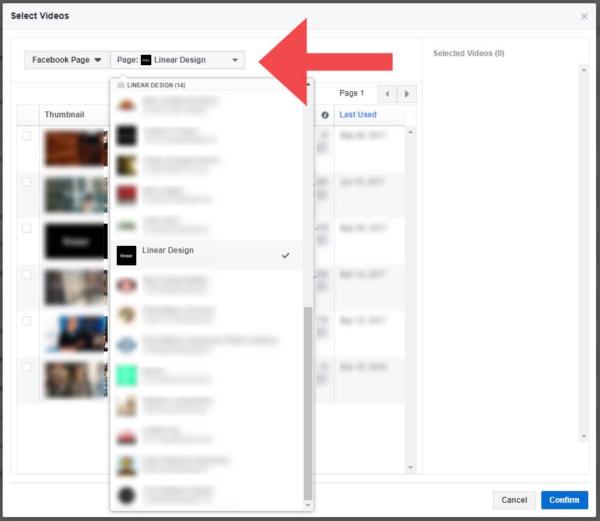
Select videos posted to your Facebook page
👉 Use the checkbox to the left of each video to select it for use in your audience. Videos that are selected will now appear in the “Selected Videos” column.
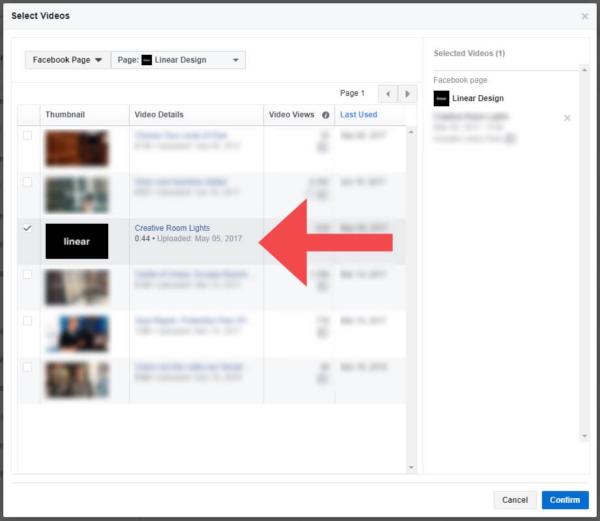
Selected videos appear in the right column
👉 Specify time frame (between the past 1 and 365 days) and finish.
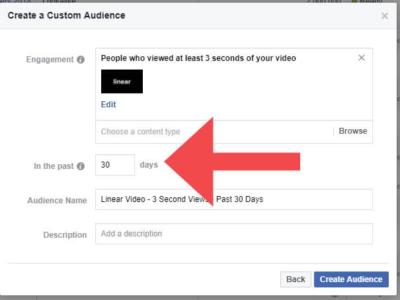
Choose how far back to target people that engaged with your video
6. Create a Facebook Custom Audience Targeting Lead Forms Engagement
If you are using Facebook lead forms, you can retarget anyone who engages with the form.
To start, choose the Engagement custom audience option.
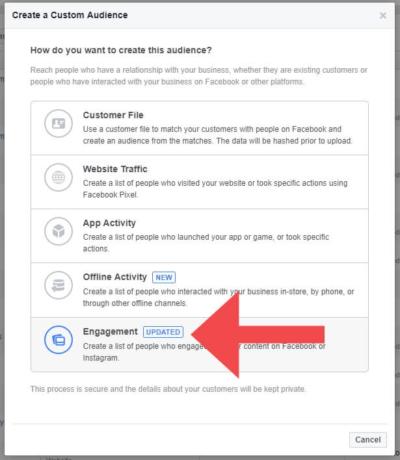
Create an audience based on engagement
👉 Select Lead Form.
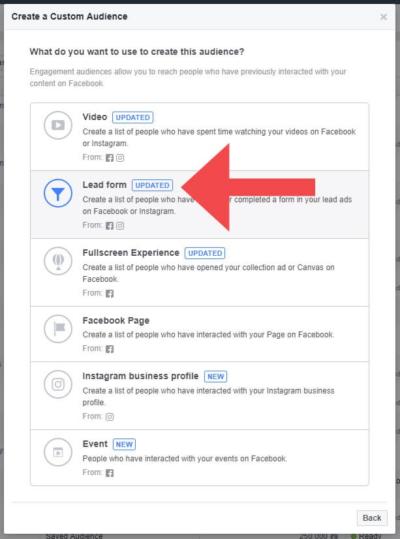
Target people who engaged with your lead forms
👉 Use the drop-down to select whom you want to include in your audience.
Options include anyone who opened your form, opened the form but did not submit, or who both opened and submitted the form. Specify a timeframe for the form action (the past 1 to 90 days).
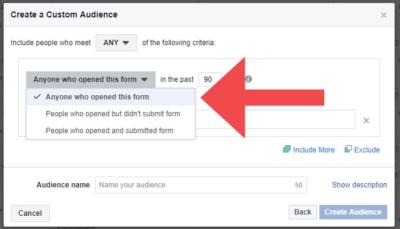
Choose who you want to include
👉 Use the dropdown menu to select the Facebook page containing the form or forms you wish to use for this audience.
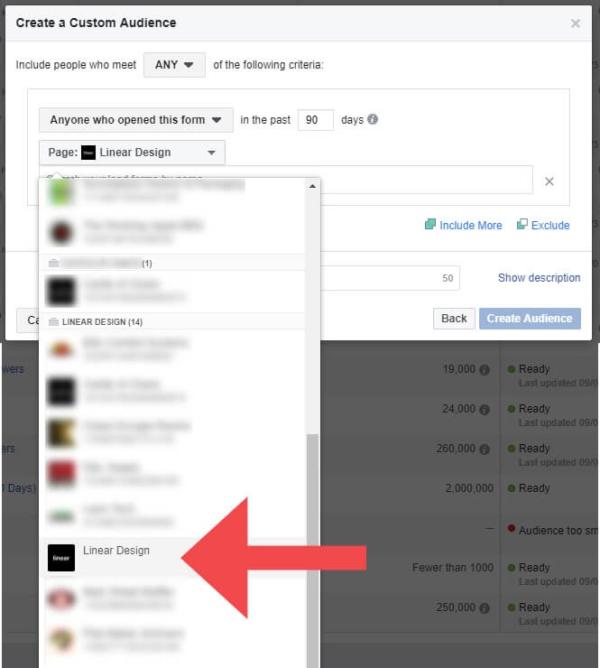
Select your Facebook page
👉 Use the drop-down to choose a form that users must interact with to be included in your audience. You must have already created an ad using lead forms on the Facebook page you’ve chosen for the form to appear in the list. Here is Facebook’s official guide to creating Lead Form ads.
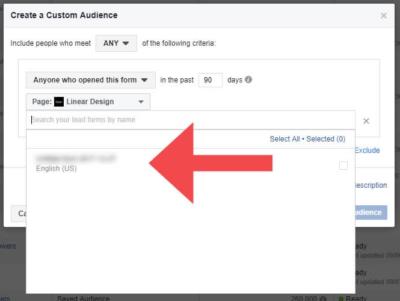
Pick your lead form
👉 Name and finish the audience.

Give your audience a name
7. Creating a Facebook Custom Audience Targeting Full-Screen Experience Engagement
If you’re using Fullscreen Experience ads, you can target users by their interactions with your canvas.
👉 Click the Engagement audience.
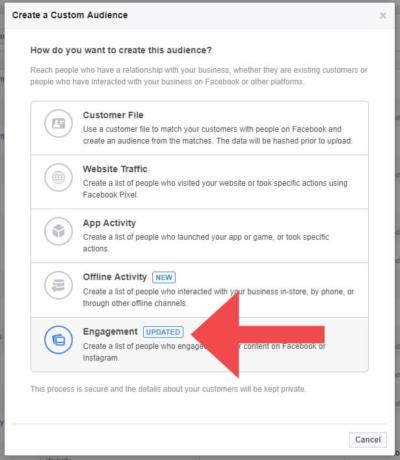
Base your audience on engagement
👉 Within the Engagement options, select Fullscreen Experience.
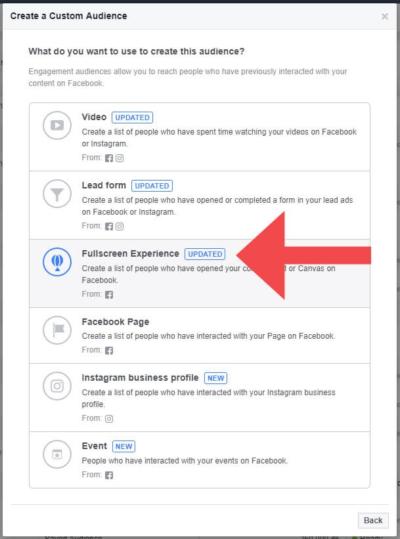
Choose fullscreen engagement
👉 Include audience based on interactions with your canvas. Interactions include users who only opened, or opened and clicked in your canvas within the past 1 to 365 days.

Decide who should be included
👉 Select the page containing your canvas, then click “select specific canvas” to choose which canvas users have to interact with to be included in your audience.
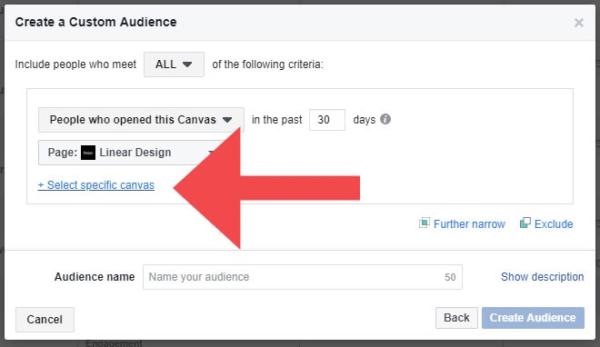
Select a canvas
👉 Finally, name your audience and click the blue Create Audience button.
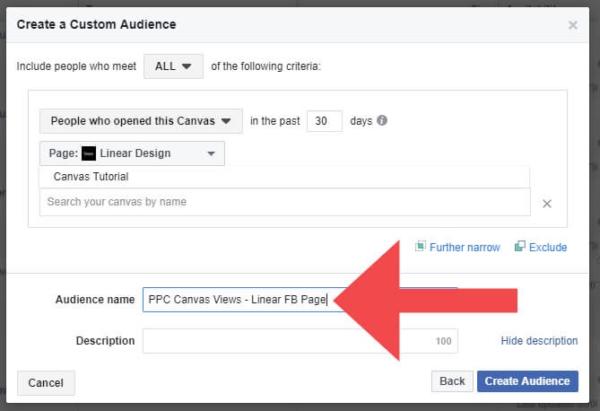
Name your audience
8. Create a Facebook Custom Audience Targeting Facebook Page Engagement
Custom Facebook page audiences target users based on the interactions they’ve had with your page.
This audience type can be beneficial if you have a large following on Facebook. Then you can target people who’ve interacted with your organic posts to incentivize them to buy.
👉 In the Create a Custom Audience menu, select Engagement.
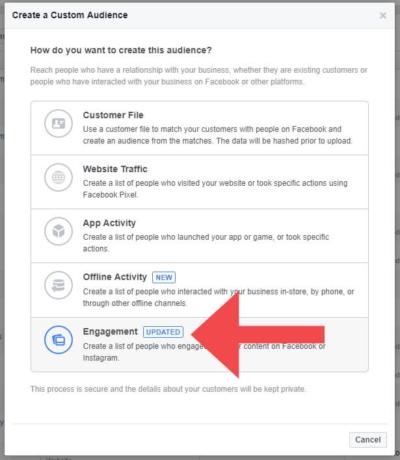
Include people based on engagement
👉 Then click Facebook Page.
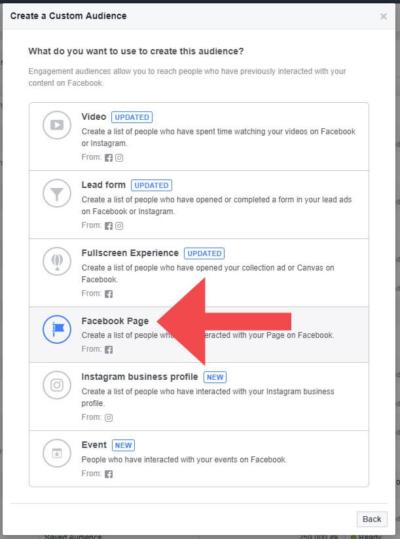
Select Facebook Page
👉 Include anyone who has interacted with your page, posts, or items. Additionally, specify if the interaction should have occurred between the past 1 to 365 days.
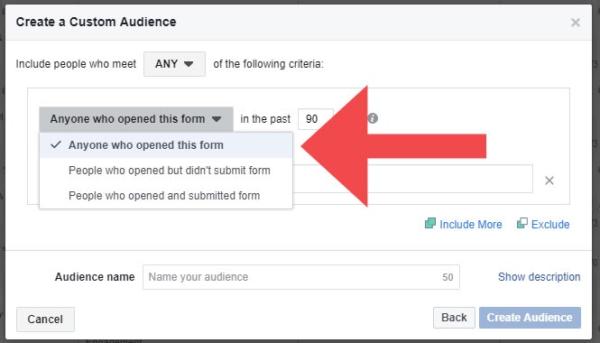
Decide who you want to include
👉 Finally, name your audience and click the blue “Create Audience” button.
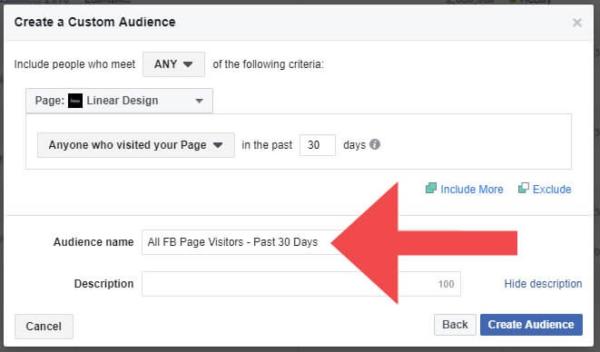
Name your audience
9. Create a Facebook Custom Audience Targeting Instagram Business Profile Engagement
If you want to show (and improve) your ads and results on Instagram, this audience type is a must. Here’s how:
👉 After selecting the Engagement audience option…
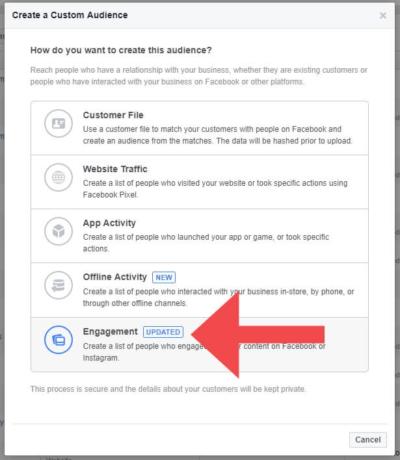
Click on engagement
… select the fifth option on the list titled Instagram business profile.
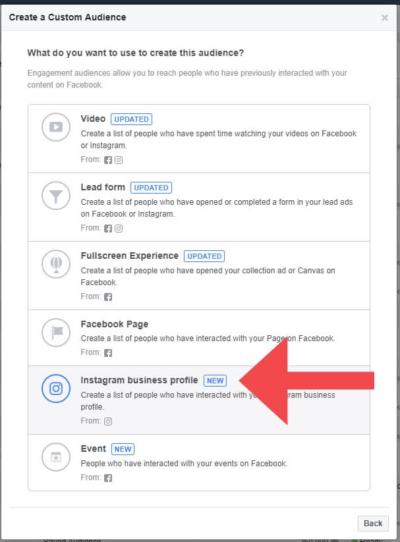
Base your audience on engagement with your Instagram business profile
👉 Use the drop-down tab to select the Instagram account you want to use for this audience.
Remember to link the Instagram account to your Facebook page. You can read Instagram’s official guide to linking your Facebook and Instagram account here.
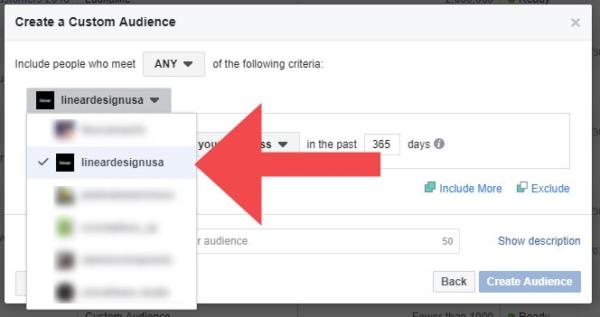
Select your Instagram business profile
👉 Use the dropdown to decide who will be included in your audience. You can choose from everyone who visited your profile, to people who saved your post or ad, and more.
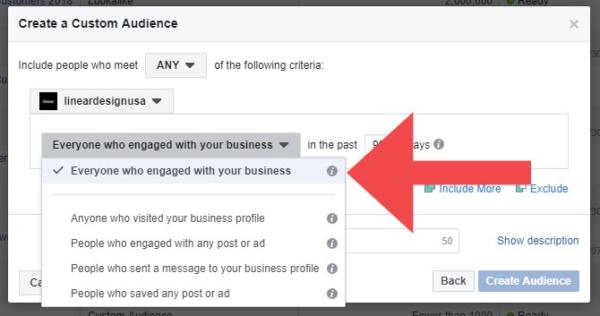
Decide who you’re going to include
👉 Set a timeframe, name, and finish the audience.
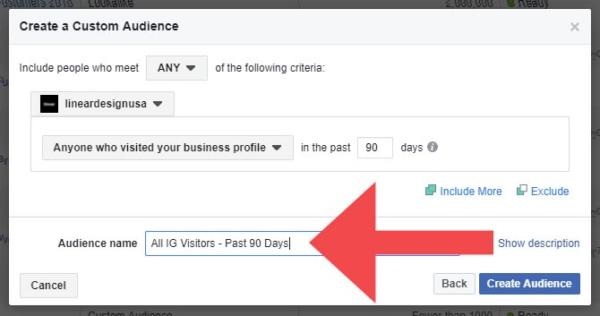
Give your audience a name
10. Create a Facebook Custom Audience Targeting Event Engagement
The Event Engagement audience type allows you to target users that attended your event. Use this audience to show ads to the users that attended your last event. There’s probably a good chance they’ll come to the next one.
👉 Select Engagement.
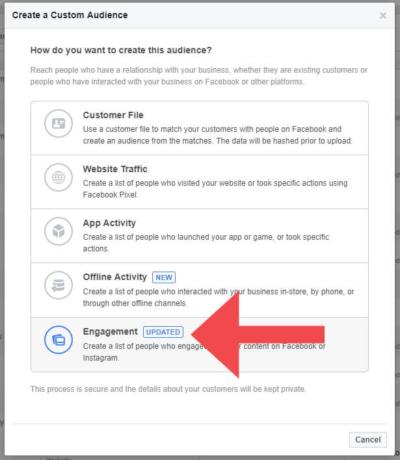
Create audiences based on engagement
👉 Choose the event option Event.
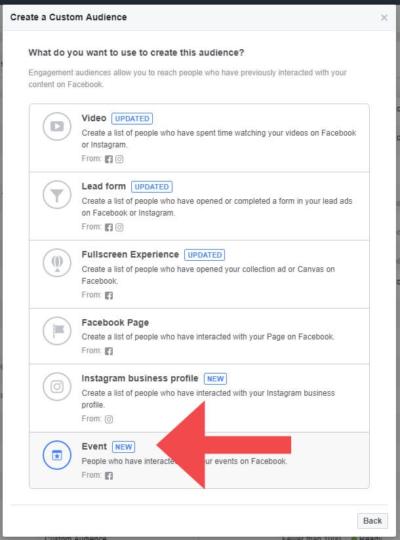
Event engagement
👉 Specify qualifying past event interactions and a lookback window between 1 and 365 days.
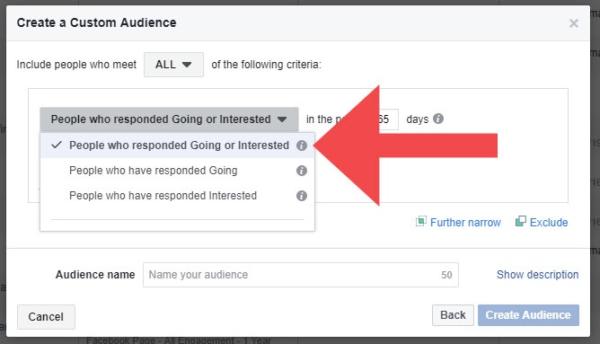
How visitors interacted with your event
👉 Select the page containing your events. Then click “select specific events” to choose which events users have to interact with to be included in your audience.
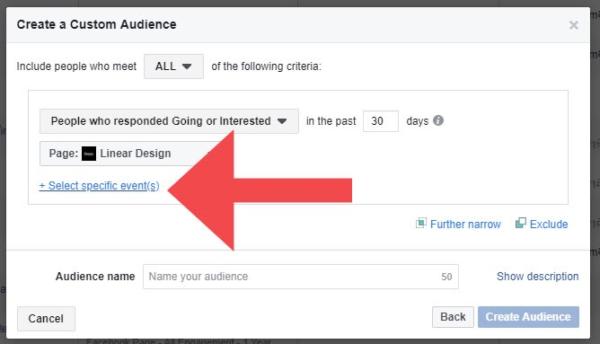
Choose which events you want to include
👉 Name and finish the audience.
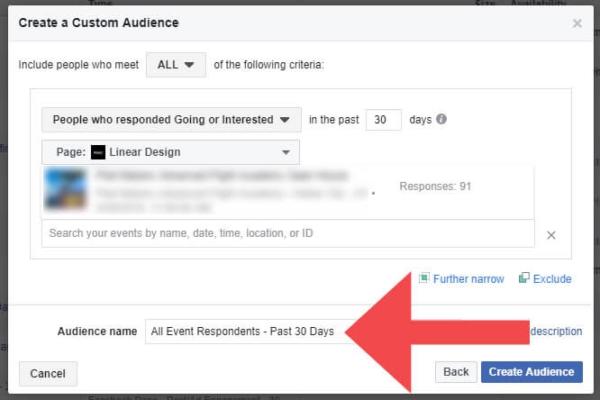
Name the audience
You’ve reached the end of the guide, congrats! 🙌
If you want to learn more about Facebook advertising, check out these guides by LinearDesign:
Luke Heinecke
Founder/CEO
Luke is in love with all things digital marketing. He’s obsessed with PPC, landing page design, and conversion rate optimization. Luke claims he “doesn’t even lift,” but he looks more like a professional bodybuilder than a PPC nerd. He says all he needs is a pair of glasses to fix that. We’ll let you be the judge.
Leave us a comment.
Subscribe to our blog
Subscribe to our blog
Get weekly PPC & CRO advice sent straight to your inbox.